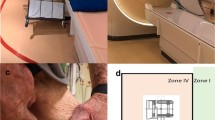Abstract
Objectives
Outsourcing of radiological reporting services has fundamentally altered communication between radiologists and clinicians in clinical decision making, which relies heavily on diagnostic imaging. The aim of this study was to understand clinicians’ perspectives and experiences of interpretation of outsourced reports in clinical practice, if the author of imaging reports matters to clinicians, and actions taken to deal with perceived errors.
Methods
A printed survey was distributed to a purposive sample of 50 of the 250 senior medical and surgical staff of a large National Health Service hospital in the UK who regularly engaged with the Radiology Department between May and October 2017, representing 20% of this hospital workforce. The survey consisted of ten questions examining clinicians’ opinions on radiology reporting, with comment options to encourage respondents to give further detail. Participants were requested to return the survey to the study investigators.
Results
The survey elicited a 100% response rate (n = 50). A constant comparative framework was used to guide analysis, revealing themes relevant to the ongoing inter-professional relationship between clinicians and radiologists. The disparity between in-house and externally sourced radiology reports and underlying issues of trust surrounding outsourced reports were the most significant themes identified.
Conclusions
This study found outsourcing of radiology reporting needs multi-disciplinary team availability regarding the interpretation and discussions around capacity for effective communication. It raises important issues around often under-acknowledged additional workloads imposed on in-house radiologists. There are financial and pragmatic clinical aspects in pathways of radiology practice which require further research and examination.
Key Points
• Utilisation of outsourcing is increasing in practice in response to imaging demands.
• Outsourcing increases departmental primary reporting capacity but may increase the workload of the local radiologist.
• The development of strategies for outsourcing examinations may lessen demands on the in-house workforce.
Similar content being viewed by others
References
Royal College of Radiologists (2017) Clinical radiology UK workforce census 2016 report. Royal College of Radiologists, London Contract No.: BFCR (17)6
Royal College of Radiologists (2014) Cancer multidisciplinary team meetings - standards for clinical radiologists. Royal College of Radiolgists, London Contract No.: BFCR (14)15
Balasubramaniam R, Subesinghe M, Smith JT (2015) The proliferation of multidisciplinary team meetings (MDTMs): how can radiology departments continue to support them all? Eur Radiol 25(12):3679–3684
Kane B, Luz S, O’Briain DS, McDermott R (2007) Multidisciplinary team meetings and their impact on workflow in radiology and pathology departments. BMC Med 5:15. https://doi.org/10.1186/1741-7015-5-15
Davis A (2008) Outsourced radiology: will doctors be deskilled? BMJ 2008:337. https://doi.org/10.1136/bmj.a785
Brady AP (2017) Error and discrepancy in radiology: inevitable or avoidable? Insight Imaging 8(1):171–182. https://doi.org/10.1007/s13244-016-0534-1
Sibanda L, Engel-Hills P, Hering E (2017) Radiology demand and capacity: a stochastic analysis based on care pathways. Cogent Business & Management 4(1):1334994. https://doi.org/10.1080/23311975.2017.1334994
Corbin C, Strauss A (2008) Basics of qualitative research, 3rd edn. Sage, London
Bryman A (2008) Social research methods, 3rd edn. Oxford University Press, New York
Creswell J (2009) Research design: qualitative, quantitative and mixed-methods approaches, 3rd edn. Sage, London
Charmaz K (2014) Constructing grounded theory. 2nd edn. Sage, London
Brady A, Laoide RÓ, McCarthy P, McDermott R (2012) Discrepancy and error in radiology: concepts, causes and consequences. Ulster Med J 81(1):3–9
Blumberg S, Mahajan PV, O’Connell KJ et al (2017) Radiologic safety events within a pediatric emergency medicine network. Pediatr Emerg Care 33(2):92–96
Royal College of Radiologists (2010) Teleradiology and outsourcing census. Royal College of Radiologists, London
Chasin BS, Elliott SP, Klotz SA (2007) Medical errors arising from outsourcing laboratory and radiology services. Am J Med 120(9):819.e9–819.11
Gutzeit A, Heiland R, Sudarski S et al (2018) Direct communication between radiologists and patients following imaging examinations. Should radiologists rethink their patient care? Eur Radiol. https://doi.org/10.1007/s00330-018-5503-2
Funding
The authors state that this work has not received any funding.
Author information
Authors and Affiliations
Corresponding author
Ethics declarations
Guarantor
The scientific guarantor of this publication is Dr. Julie Cox.
Conflict of interest
The authors of this manuscript declare no relationships with any companies whose products or services may be related to the subject matter of the article.
Statistics and biometry
No complex statistical methods were necessary for this paper.
Informed consent
Written informed consent was not required for this study because the participants were hospital staff, and written informed consent was waived by the Institutional Review Board.
Ethical approval
Institutional Review Board approval was obtained.
Methodology
• retrospective
Rights and permissions
About this article
Cite this article
Graham, Y., Hayes, C., Mehrotra, P. et al. Clinicians’ perceptions of the quality of outsourced radiology and actions taken around perceived imaging errors in practice. Eur Radiol 29, 1649–1654 (2019). https://doi.org/10.1007/s00330-018-5873-5
Received:
Revised:
Accepted:
Published:
Issue Date:
DOI: https://doi.org/10.1007/s00330-018-5873-5




